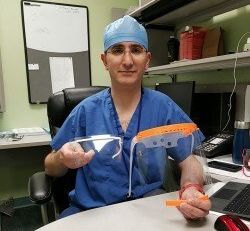Joseph S. Hanna. Courtesy of Rutgers
When Joseph S. Hanna purchased his first CR-10 3D printer roughly four years ago, he never imagined he would one day be using the hobby he loves to have an impact in his chosen profession.
As an acute care surgeon—a specialty encompassing trauma, critical care and emergency surgery—Hanna is well versed in acting quickly during times of crisis—evaluating critical problems and using his skills to help craft a solution. Perhaps it is no surprise, then, that he took this same approach and translated it to the current COVID-19 global pandemic.
Hanna serves as assistant professor and medical director of emergency general surgery in Rutgers Robert Wood Johnson Medical School’s Division of Acute Care Surgery, where he works with the trauma and acute care surgery teams at Robert Wood Johnson University Hospital. He is also a 3D printing enthusiast, now using his skills to help find solutions to dwindling PPE (personal protective equipment) resources.
A few days after reading about how Czech inventor and one of the giants in the 3D printing industry, Josef Prusa, had developed a series of Ministry of Health–verified prototypes to create a design for face shields, Hanna learned healthcare teams in the area were running low on this PPE and immediately thought he could help provide a solution.
“I used Prusa’s design for the face shield and went to Staples to pick up some Fellowes crystal presentation covers, which I cut out by hand to create the clear shield,” Hanna said. “I found a design for eye shields that is practically identical to the commercially purchased ones we use here and started 3D printing those as well. I really focused on those because there are technological limitations that make face mask production more difficult.”
Because safety is critical, Hanna said he limited his current efforts to designs that have already been industry-proven. Face masks and filters are still being tested with regard to their safety and efficacy, but more is expected to come in that area as large corporations such as Hewlett Packard submit their 3D-printed designs for expedited approval and review, he noted.
Hanna initially produced eight face shields and 10 eye shields, which he distributed to the acute care surgery division at Robert Wood Johnson University Hospital New Brunswick, as well as the Intensive Care Unit at Robert Wood Johnson University Hospital Somerset. He already has received requests for additional shields from other departments as well. And, since the shields can be sterilized with ultraviolet (UV) light, they are a valuable resource in the event PPE supplies become more limited.
Because the 3D printing machines he has at home are intended for hobby, rather than industrial use, the number of face/eye shields he is able to produce is limited.
“Anyone who needs it, I would love to help. It’s just a slow process and not a very high volume,” Hanna said. “But, if we can mobilize the 3D printing community to use the tested patterns that are out there, it would be a great way to help meet what’s needed. If even 1,000 of the hobbyists in New Jersey and the surrounding area could print 10 face shields, that’s an additional 10,000 shields we’d have for the healthcare providers who need them.”
Rutgers is now in the process of coordinating efforts of Hanna and others’ 3D printing expertise as part of an RU 3D PPE Project (or RU3DP2 for short) to bring together the university’s wealth of knowledge, skills and abilities to assist the Rutgers COVID-19 Task Force in overcoming shortages of PPE for frontline health care workers.
Source: Rutgers Robert Wood Johnson Medical School

Be the first to comment on "Surgeon Turns to Hobby for PPE Solutions"